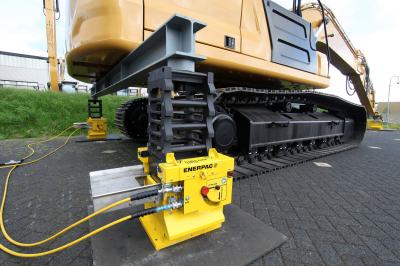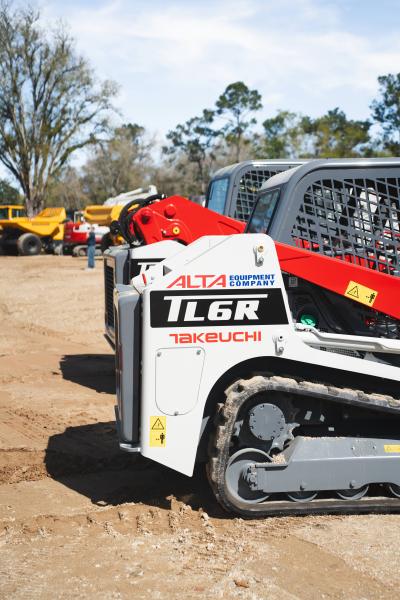nternet technology is bringing smiles to the faces of contractors, dealers and equipment manufacturers, who save time and money by using the Worldwide Web, completing many transactions with the speed of light instead of ponderous paperwork.
Via the Internet, construction industry personnel can now bid on highway projects, participate in auctions throughout the world, locate and purchase everything from a backhoe to a compactor, research entire lines of equipment and obtain a host of other valuable services.
Here’s an overview of how Web technology is drastically changing the construction business, with efficiencies that save millions of dollars.
Highway Bids
Numerous state Departments of Transportation (DOTs) are now using, or in stages of implementing, software systems for all-electronic “two-way” bidding on highway and bridge projects. This technology greatly simplifies the bidding process for contractors and states.
“States create everything electronically and have their contractors download bids electronically,” explained Charles “Chuck” Conley, project manager of the American Association of State Highway and Transportation Officials (AASHTO) in Washington, D.C.
Highway contractors are eagerly adopting electronic bidding, Conley said, and added: “It [electronic bidding] has started to grow really strongly in the last 12 months or so. It’s being looked at by more and more states. I hear different reports from many states and some of the growth is because contractors are saying to some states: ’Why don’t you use that nice [electronic] system like ’State X’? I’m used to that system. I like it. It really facilitates my ability to put together a good timely bid for you with the best prices I can give you.”
Contractors usually prepare their own electronic bids using AASHTO’s Expedite software, which is a module of its Trns.port product, downloading project information in a format resembling a spreadsheet, and adding prices. The program also allows the contractor to include bid bond reference with a surety agency, as well as miscellaneous information and legal documents, in their electronic bid file.
Both the DOTs and contractors also can utilize other software for 100-percent, two-way electronic bidding. Info Tech’s Bid Express (BidX) system, which acts as a repository of information, including DOT schedules of upcoming bids, is widely used. Contractors who subscribe to the service receive electronic notices of the work.
“It is a very, very secure encrypted protocol so that bids can only be opened by the proper people at the proper time,” Conley said.
States leading the field in 100-percent electronic bidding include Pennsylvania, Georgia, Iowa, Wisconsin, Michigan, Oklahoma, Arizona, New Mexico, North Carolina, South Carolina and Virginia.
“Most other states are also moving towards similar systems; there’s a lot of interest,” said Conley.
Thirty-six states are licensed Expedite users and are at various stages of implementing full electronic bidding using the Web, though not all subscribe to BidX to go 100 percent all-electronic. AASHTO has made presentations on the software to New Jersey and, Conley said, “chances are they will do something with it.”
When a state has installed the all-electronic system, contractors benefit in increased efficiency and savings.
“Most contractors are pushing for more of the electronic systems because it makes their job much easier,” Conley told Construction Equipment Guide (CEG). “If you’re a contractor and you want to bid on jobs in states like Nebraska, Kansas, Colorado and Wyoming, they all have different letting schedules and requirements. If you can submit your bid electronically, you don’t have to travel there to get the bidding documents or to submit documents, and the contractor can submit, or even pull, the bid right up to the last second.”
Conley said some states have electronic bidding systems but are considering the use of AASHTO’s Expedite and — perhaps BidX — to move to full, automated, electronic bidding.
The Pennsylvania Department of Transportation (PennDOT) let its first all-electronic bid award last fall and hopes to award all bids online by this July. The DOT is requiring that all contractors and subs bid electronically after registering as a “business partner.”
AASHTO’s Web site is transportation.org
Auctions
Auctions of construction equipment often now include Internet bidding from “remote” locations that can be thousands of miles from the actual auction site. The big advantage is the amount of time that the bidder saves. People who use this system can participate in 10 auctions per week, rather than two per week.
Ritchie Bros. Auctioneers, for instance, headquartered in Vancouver, British Columbia, now includes live Internet bidding on more than 80 percent of its auctions. Almost 4,000 users from more than 50 countries are registered to access the service.
Live bidding is done in real time via conventional computers, without special modifications. Ritchie downloads a small package of software, designed for easy use, from its Web site, and recommends a high-speed Internet connection.
In Ritchie’s system, the bidder hears the auctioneer, sees a photo of the item being sold, and views high-bid and ask prices on the computer display.
To make a bid, the remote user simply activates the bid button on the display by selecting the lot he wants to bid on, and clicks on the button to bid at the amount that is shown. (The value on the button changes with the auctioneer’s call and always reflects the current ask price.)
Messages displayed above the button tell the Internet bidder when he is the high bidder and when he has been outbid. If he is the high bidder when the auctioneer says “Sold,” he sees a “Sold to You” message.
The system uses an “eClerk” who listens to the auctioneer and uses mouse clicks to send out the current bid and current ask price. Advanced software allows this person to follow the auctioneer’s call and send it out through the Internet in real time.
As bids come in from Internet users, an “eRingman,” watching a different computer, sees his screen light up, flash the amount of the bid in red, and identify the bidder. He then signals that bid to the auctioneer.
The Ritchie Bros. live bidding service, rbauctionBid-live, was launched at the ConExpo/ConAGG trade show in March 2002. It accounted for $76 million in purchases by the end of the year. Sales to Internet bidders recently topped the $100-million mark.
“Internet bidding from all around the world continues to grow very quickly,” said Bob Armstrong, Ritchie’s vice president of Internet services. “We’re having more and more success in Europe, which now appears to be gaining the same kind of momentum that we enjoyed in North America last year.
“Internet bidders are now competing on as many as 40 percent of the lots being offered online. This is way beyond what it was when we started.
“The most important statistic is that Internet bidders are the buyer or runner-up on roughly 12 percent of the lots. This means that, absent them, those lots sold for less. So, if I’m a consignor, I’m pretty excited now. Ritchie Bros. is already delivering good prices, but now, thanks to the Internet tool, the price on roughly 12 percent of the assets being sold online just went up.
“Our unreserved auctions have always attracted a very international audience. Statistics show us that 50 percent of what we sell at unreserved auctions goes to people from outside the region in which the auction is being held. So international registrations are high but, for sure, the Internet has added to that. Most of the people using this tool are not from the local region. The vast majority is from other states, other provinces, and, in large part, from other countries as well. We’ve had significant registrations into our North American auctions from South America, the Middle East and Europe.”
Armstrong said Ritchie Bros. is using the Internet for an increasing number of auction sales at temporary “off-site” contractor locations as well as at its 28 regular auction sites where approximately 80 percent of its auctions are held.
“Internet bidding has proven so popular with our buyers that we are really just responding to our customers’ demands,” Armstrong said. “It is now an absolutely integral part of most auctions. An average of about 15 percent of the registered bidders are now Internet bidders. The vast majority of bidders, however, are still attending the sale in person. We don’t think that will ever change. This is hugely important to us. The live unreserved auction remains the very best way to buy and sell equipment. The Internet is simply a tool that enhances that, but it does not replace it.”
During 2002, there were 156,000 registered bidders at 141 Ritchie Bros. auctions, with gross auction sales exceeding $1.37 billion. Because it increases the number of bidders, Internet bidding is a boon to consignors and a competitive advantage.
Armstrong said most Internet bidders investigate the equipment before the auction.
“At the most basic level, they visit our Web site several days before, view a digital photograph of the pieces, and read descriptions of the pieces. If they want to go to a further level of detail, and in most cases they do, they can either send someone to the sale site where all the equipment is marshaled and on display, or even go themselves. We absolutely strongly encourage all bidders to do that [inspect equipment on-site]. In the case of an older piece, quite a bit of inspection is required. There are no guarantees or warranties. The Internet bidder is in the same situation as the live bidder — as is, where is.”
On auction day, bidders can be at their office, job sites or wherever they need to be. “When it’s time to bid on a piece, they just fire up their computer and bid with a minimum of commitment of time,” Armstrong said.
Armstrong said Ritchie Bros. will continue to enhance and improve the system as it receives feedback from customers and as technology advances.
Further information is available at [email protected]
Manufacturers
Manufacturers provide full information on their products, and often online ordering, through the Internet.
Stone Construction Equipment, Honeoye, NY, for instance, operates a “public site” where you can check out its mixers, compactors, and other products, and request a quote if you decide to order. The site also shows used equipment available from Stone (or from some of its dealers). Users also can download operator manuals and access basic technical information.
“The quote system is pretty unique,” said Kathryn Reissig, Stone’s marketing services manager. “Users can configure the product the way they want it, including the size, engine, options, and accessories. The minute they push the button for a quote, we will forward it to the dealer who will quote the actual price. We do all that in about five minutes.”
Stone also operates a private “eBusiness” site. A dealer can log in here and receive a wide variety of information, including complete technical updates on products in “product and parts shopping carts.” Dealers also can order products, both machines and parts, online. Here, again, they can create and order their own product configurations.
Customers also can file warranty claims and view parts or parts diagrams for maintenance purposes.
The eBusiness site, established in February 2002, provides customers with their own account home page after they log in with their password.
“It’s all geared toward their business; they will get their pricing; customized for them,” Reissig said. “The site recognizes them when they log in, and contains what they’ve ordered in the past, their various shipping addresses and other information.
“From our standpoint, the system reduces some of our back-end costs by having things coming directly to us. It’s another touch point for both our dealers and the contractor and end-user. We know that using the Web reduces their back-end administrative costs by anywhere from $30 to $60 per purchase order basically by reducing paperwork.
“We’re also exploring some other things that we want to be able to do, like financial calculators. We do offer our own financing services, calculating payments and things like that. We’re looking at an online purchasing system in which our products can be shipped to a variety of locations as authorized through our central system.”
Stone was one of the first light equipment manufacturers to establish an e-commerce site.
It received a top award from the American Rental Association in February for this accomplishment benefiting dealers.
AEM Web Site
The Association of Equipment Manufacturers (AEM) in Milwaukee, WI, provides a full Web site that helps members quickly access new information.
“We provide an information portal [through the Internet] to our members,” said Chuck Frey, AEM’s director of strategic information services. “We are trying to provide them with the information that they need to do business. This includes industry news, economic trends, special reports in areas like rental and international marketing.”
The AEM Web site also provides a product locator, which allows contractors to research manufacturers’ equipment by type and subtype. If a contractor needs a backhoe loader, for instance, he or she can go to the heavy construction equipment category on the site, check the loader backhoe subcategory, and view contact information for any AEM manufacturers that make that type of machine.
“We are getting a lot of hits [people accessing the location],” said Frey. “The site is quite popular with our members and usage is quite large.”
AEM’s Web site is aem.org. It won a Standard of Excellence award last year from the Web Marketing Association.
AEM also is doubling its e-seminar program this year to provide “distance learning” to manufacturers of construction and agricultural equipment. Subjects include technical operations, economics, the Web, tradeshow design and coordination, and global business. It has established a pay-for-view “cybrary” online e-seminar archive.
Changing Fast
Recognizing that use of Web technology is increasing fast, the Associated General Contractors of America (AGC) in Washington, D.C., last spring prepared an on-line e-mail survey of members asking six questions, carefully crafted to gauge their Internet usage. Typical topics covered use of the Web for project management, and which online management software they employed. Approximately 70 percent of the respondents were general contractors.
AGC now is embarking on a second survey to get an even better handle on usage.
“Some people aren’t using the Internet at all and some are using it for a lot of different things,” said Lakisha Campbell, AGC’s senior director of e-business and marketing. “The adoption of technology has changed drastically just in the last six months. To measure that, we truly have to continue to do polling samples of our membership.”
Results of the first survey are available on AGC.org echnology.
Dealer Web Sites
The Associated Equipment Distributors (AED) in Oak Brook, IL, is urging dealers to establish Web sites for online service, and is even offering a complimentary Web site analysis and evaluation to members.
“It wasn’t too long ago that building a Web site was almost a novelty,” said the AED newsletter. “Times have definitely changed. Now, Internet usage is at an all-time high. Searching for construction equipment, distribution, industry products, and services on the Web has become commonplace. Having a powerful Web presence can easily lead to increased sales and improved customer relationships that will only serve to make your business grow.”
AED said a dealer Web site should increase sales inquiries for new and used equipment and expand the dealer’s market reach.
“A solid Web site is now an essential part of a company’s marketing plan, as important as a print piece,” said Rich Rosell, AED’s manager of Internet services. “Not only can customers view a dealer’s products via the Internet, but the Web site is up 24 hours a day.
“People can leave e-mail inquiries in the middle of the night, which you can answer first thing in the morning. It’s like having your business open day and night.”
Rosell said some dealers are implementing online (automatic) ordering, though, in the majority of cases, dealers simply follow up on inquiries made through the Internet.
AED’s own Web site includes an article describing how Reed Company LLC, a dealer in Wamego, KS, sold products to customers in Thailand, Vietnam and Mexico after putting its inventory online. The article quoted owner Don Ebert as saying: “We’re amazed at how many people who are within 100 miles of us didn’t know we existed until they found us on the Internet.”
The company updates its site every day with items being offered for purchase, and receives at least 30 e-mails per day from people who are interested in certain products.
After receiving up to two e-mails and two telephone calls per day from Thailand, and responding with photos and information on trencher equipment, Reed sold two trenchers, plus manual and spare parts to the Thailand customer.
AED also cites the case of Burris Equipment Co. of Northern Illinois, whose Web site features a full guide of rental rates plus job opportunities and the company’s monthly newsletter of specials and new or used equipment.
Further information is available on aednet.org.
Today's top stories














